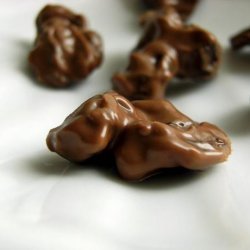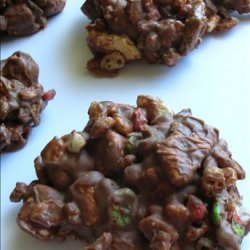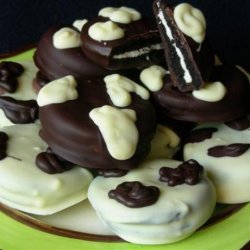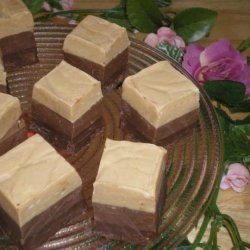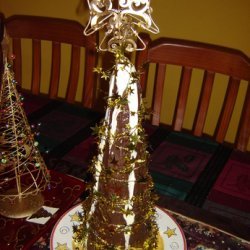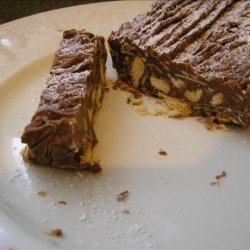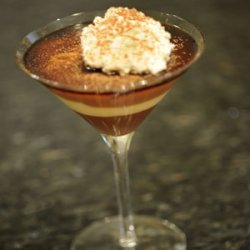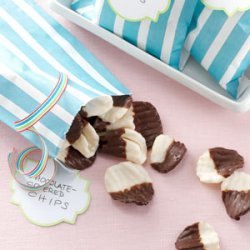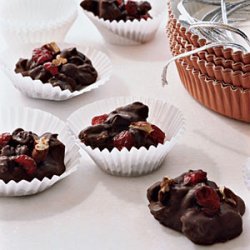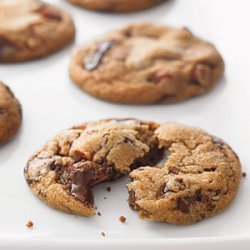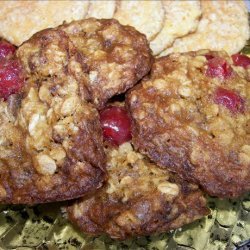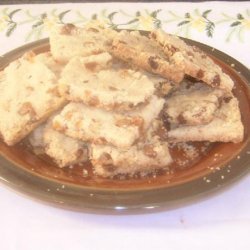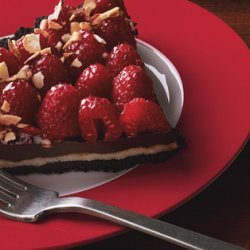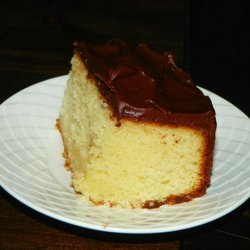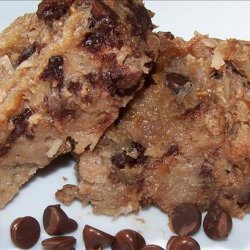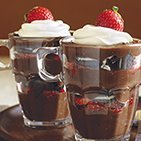Directions:
- For the Base of the Crate: Using an offset spatula, spread a 1/4-inch layer of tempered white chocolate onto a sheet of parchment paper or acetate, being sure to spread it all the way to the edges. Lift the chocolate-covered paper by its corners and move it to a clean space on your work surface. Let the chocolate harden slightly, 4 to 5 minutes. Pour a little milk chocolate over one end of the slightly set white chocolate. Pull the wood grain tool through the chocolate to create a wood grain design. Let the chocolate set slightly, until firm but not hard. Using the tip of a sharp paring knife or an X-Acto knife, cut 4 strips of chocolate, 18 by 2-inches. Cut 2 more strips of chocolate, 11 by 2-inches each.
- For the Sides of the Crate: Repeat the process and cut 2 strips 18 by 2-inches and 2 strips 11 by 2-inches. Cut 8 pieces 2 by 1-inch. These will be the supports for the sides and will hold the base to the sides.
- Assemble the Crate: On your work surface, place 4 (18 by 2-inch) strips spaced about 1/2-inch apart. Place 2 (11 by 2-inch) strips across the 4 (18 by 2-inch) strips towards the ends. Use white chocolate to glue the 2 strips in place. Divide the 1 by 2-inch pieces into pairs and glue each pair together along the long side, creating a right angle, or an L-shape. Stand the L-shaped chocolate pieces on their ends on each corner of the base, and glue them down about 1/4-inch from the outside edge of the base. Allow the chocolate to set.
- To glue the sides onto the base, glue the 2 remaining 18 by 2-inch strips and the 2 remaining 11 by 2-inch strips perpendicular to the base on the reinforcement corner. Position them so the bottoms of the strips are one inch above the base. Allow the chocolate to set.
- For the Hay: Place a large block of ice on a sheet pan and place on your work surface. Make a cornet and fill with the untempered white chocolate. Drizzle long strands of chocolate directly on top of the block of ice. The chocolate will set immediately but remain flexible. Lift the chocolate hay off the ice and gently bend to fit inside the crate.
- How to Temper Chocolate(From Dessert Circus, Extraordinary Desserts You Can Make At Home by Jacques Torres):
- Chocolate is tempered so that after it has been melted, it retains its gloss and hardens again without becoming chalky and white (that happens when the molecules of fat separate and form on top of the chocolate). There are a variety of ways to temper.
- One of the easiest ways to temper chocolate is to chop it into small pieces and then place it in the microwave for 30 seconds at a time on high power until most of the chocolate is melted. Be very careful not to overheat it. (The temperature of dark chocolate should be between 88 and 90 degrees F, slightly warmer than your bottom lip. It will retain its shape even when mostly melted. White and milk chocolates melt at a temperature approximately 2 degrees F less because of the amount of lactose they contain.) Any remaining lumps will melt in the chocolate's residual heat. Use an immersion blender or whisk to break up the lumps. Usually, chocolate begins to set, or crystallize, along the side of the bowl. As it sets, mix those crystals into the melted chocolate to temper it. A glass bowl retains heat well and keeps the chocolate tempered longer.
- Another way to temper chocolate is called seeding. In this method, add small pieces of unmelted chocolate to melted chocolate. The amount of unmelted chocolate to be added depends on the temperature of the melted chocolate, but is usually 1/4 of the total amount. It is easiest to use an immersion blender for this, or a whisk.
- The classic way to temper chocolate is called tabliering. Two thirds of the melted chocolate is poured onto a marble or another cold work surface. The chocolate is spread out and worked with a spatula until its temperature is approximately 81 degrees F. At this stage, it is thick and begins to set. This tempered chocolate is then added to the remaining non-tempered chocolate and mixed thoroughly until the mass has a completely uniform temperature. If the temperature is still too high, part of the chocolate is worked further on the cold surface until the correct temperature is reached. This is a lot of work, requires a lot of room, and makes a big mess.
- A simple method of checking tempering, is to apply a small quantity of chocolate to a piece of paper or to the point of a knife. If the chocolate has been correctly tempered, it will harden evenly and show a good gloss within a few minutes.
- How to Make a Cornet(From Dessert Circus, Extraordinary Desserts You Can Make At Home by Jacques Torres):
- The Cornet: A cornet is a small piping bag made from parchment paper. It is usually used to make fine decorations.
- Cut an 8 by 12 by 14 1/2-inch triangle from a sheet of parchment paper. Hold the middle of the long side of the triangle between two fingers of one hand. Take the tip of the triangle on the short, wide end and roll it toward the other tip of that same end while simultaneously pulling it in an upward motion. The tip of a cone will form where your thumb and finger hold it on the long side.
- Release your grip from the long side, so that you are now holding the two corners where they meet. The paper will already resemble a partially formed cone. Roll the remaining tail until it is completely rolled into a cone. There will be one point sticking up from the open end. Fold it inside toward the center, and crease the fold. Now you should have a cornet. To close the cornet once it has been filled, fold it away from the seam; this will keep the seam from opening. Use a pair of scissors or a sharp paring knife to cut an opening at the tip of the cornet to the desired size.
Nutrition Facts
| Amount Per 1 Serving | |||
| Calories | 12632.76 Kcal (52891 kJ) | ||
| Calories from fat | 6654.31 Kcal | ||
| % Daily Value* | |||
| Total Fat | 739.37g | 1137% | |
|---|---|---|---|
| Cholesterol | 517.1mg | 172% | |
| Sodium | 2254.39mg | 94% | |
| Potassium | 7144.2mg | 152% | |
| Total Carbs | 1397.09g | 466% | |
| Sugars | 1388.02g | 5552% | |
| Protein | 149.69g | 299% | |
| Vitamin C | 22.7mg | 38% | |
| Calcium | 4917mg | 492% | |
| Amount Per 100 g | |||
| Calories | 464.17 Kcal (1943 kJ) | ||
| Calories from fat | 244.5 Kcal | ||
| % Daily Value* | |||
| Total Fat | 27.17g | 1137% | |
|---|---|---|---|
| Cholesterol | 19mg | 172% | |
| Sodium | 82.83mg | 94% | |
| Potassium | 262.5mg | 152% | |
| Total Carbs | 51.33g | 466% | |
| Sugars | 51g | 5552% | |
| Protein | 5.5g | 299% | |
| Vitamin C | 0.8mg | 38% | |
| Calcium | 180.7mg | 492% | |
* Percent Daily Values are based on a 2000 calorie diet. Your daily values may be higher or lower depending on your calorie needs.
Find out how many calories should you eat.
Get Your Recipe of Health!
Follow RecipeOfHealth on Facebook!




